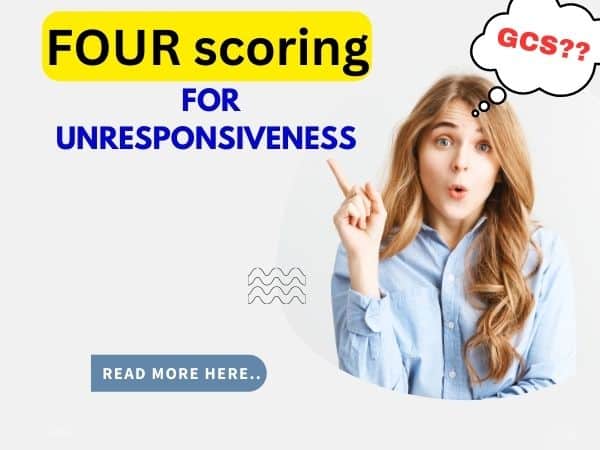What is the FOUR Score?
The FOUR Score is a neurological assessment tool that can help evaluate the level of consciousness in unresponsive patients. The name FOUR stands for Full Outline of UnResponsiveness, and it measures four domains of neurological function: eye responses, motor responses, brainstem reflexes, and respiratory patterns. Unlike the Glasgow Coma Scale (GCS), which is the most widely used scale for assessing coma, the FOUR Score does not rely on verbal responses and can detect subtle signs of brainstem impairment and locked-in syndrome.
How to Calculate the FOUR Score?
The FOUR Score is calculated by adding the scores of each domain, which range from 0 to 4. The lowest possible score is 0, indicating no neurological function, and the highest possible score is 16, indicating normal neurological function. Here are the criteria for each domain:
Eye Responses (E)
- Eyelids open or opened, tracking, or blinking to command: 4 points
- Eyelids open but not tracking: 3 points
- Eyelids closed but open to loud voice: 2 points
- Eyelids closed but open to pain: 1 point
- Eyelids remain closed with pain: 0 points
Motor Responses (M)
- Thumbs-up, fist, or peace sign: 4 points
- Localizing to pain: 3 points
- Flexion response to pain: 2 points
- Extension response to pain: 1 point
- No response to pain or generalized myoclonus status: 0 points
Brainstem Reflexes (B)
- Pupil and corneal reflexes present: 4 points
- One pupil wide and fixed: 3 points
- Pupil OR corneal reflex absent: 2 points
- Pupil AND corneal reflexes absent: 1 point
- Absent pupil, corneal, and cough reflexes: 0 points
Respiration Pattern (R)
- Not intubated, regular breathing pattern: 4 points
- Not intubated, Cheyne-Stokes breathing pattern: 3 points
- Not intubated, irregular breathing: 2 points
- Breathes above ventilatory rate: 1 point
- Breathes at ventilator rate or apnea: 0 points
How to Interpret the FOUR Score?
The FOUR Score can provide useful information about the severity and prognosis of unresponsive patients. Generally, a higher score indicates a better outcome and a lower score indicates a worse outcome. However, the score should be interpreted in the context of the patient’s clinical condition and other factors that may affect the neurological examination, such as sedation, hypothermia, metabolic disturbances, or drug intoxication.
Some studies have suggested that the FOUR Score can predict mortality and functional recovery better than the GCS in various settings, such as intensive care units, emergency departments, neurosurgical wards, and cardiac arrest patients. For example, one study found that a FOUR Score of less than or equal to 4 was associated with a mortality rate of 97%, while a GCS of less than or equal to 5 was associated with a mortality rate of 86%. Another study found that a FOUR Score of less than or equal to 6 was associated with a poor outcome (death or vegetative state) in 98% of patients after cardiac arrest.
The FOUR Score can also help identify some specific neurological syndromes that may be missed by the GCS. For instance, a patient with locked-in syndrome may have normal eye responses and brainstem reflexes but no motor responses or verbal responses. This patient would have a GCS of E1M1V1 (total score of 3), which is indistinguishable from a patient with severe brain damage. However, with the FOUR Score, this patient would have E4M0B4R0 (total score of 8), which would alert the clinician to the possibility of locked-in syndrome.
Another example is a patient with brain herniation due to increased intracranial pressure. This patient may have one pupil wide and fixed, absent corneal reflexes, extensor posturing to pain, and irregular breathing. This patient would have a GCS of E1M2V1 (total score of 4), which is similar to a patient with diffuse brain injury. However, with the FOUR Score, this patient would have E1M1B1R2 (total score of 5), which would indicate a brainstem lesion and a need for urgent intervention.
What are the Advantages and Limitations of the FOUR Score?
The FOUR Score has several advantages over the GCS, such as:
- It does not require verbal responses, which may be impaired by intubation, aphasia, or language barriers.
- It evaluates brainstem reflexes and respiratory patterns, which may reflect the location and severity of brain lesions.
- It can differentiate between locked-in syndrome and vegetative state, which have different prognoses and ethical implications.
- It can detect signs of brain herniation, which may require immediate treatment.
- It can better discriminate between different levels of coma, especially in the lower range of scores.
However, the FOUR Score also has some limitations, such as:
- It is not widely used or validated in different populations and settings, unlike the GCS, which has been extensively studied and standardized.
- It may be influenced by external factors that affect the neurological examination, such as sedation, hypothermia, metabolic disturbances, or drug intoxication.
- It may be more complex and time-consuming to perform than the GCS, which may limit its feasibility and reliability in busy or resource-limited settings.
- It may not capture some aspects of neurological function that are assessed by other scales, such as the Glasgow Outcome Scale (GOS), which measures the level of disability and dependence.
Difference Between FOUR Score Vs GCS
| Criteria | FOUR Score | GCS |
|---|---|---|
| Domains | Eye responses, motor responses, brainstem reflexes, respiratory pattern | Eye responses, motor responses, verbal responses |
| Range | 0-16 | 3-15 |
| Verbal responses | Not required | Required |
| Brainstem reflexes | Included | Not included |
| Respiratory pattern | Included | Not included |
| Locked-in syndrome | Can detect | Cannot detect |
| Brain herniation | Can detect | Cannot detect |
| Validation | Less widely used and validated | More widely used and validated |
| Complexity | More complex and time-consuming | Less complex and time-consuming |
Conclusion
The FOUR Score is a neurological assessment tool that can help evaluate the level of consciousness in unresponsive patients. It measures four domains of neurological function: eye responses, motor responses, brainstem reflexes, and respiratory patterns. It has some advantages over the GCS, such as detecting subtle signs of brainstem impairment and locked-in syndrome. However, it also has some limitations, such as being less widely used and validated than the GCS. The FOUR Score should be interpreted in the context of the patient’s clinical condition and other factors that may affect the neurological examination.
References
(1) The Full Outline of UnResponsiveness (FOUR) Score and Its Use in ….
(2) Full Outline Of UnResponsiveness (FOUR) Score Calculator – MDApp.
(3) Full outline of unresponsiveness score – Radiopaedia.org.
(4) FOUR (Full Outline of UnResponsiveness) Score – MDCalc.
FAQs
What is the FOUR Score?
The FOUR Score is a neurological assessment tool that can help evaluate the level of consciousness in unresponsive patients. It measures four domains of neurological function: eye responses, motor responses, brainstem reflexes, and respiratory patterns.
How to calculate the FOUR Score?
The FOUR Score is calculated by adding the scores of each domain, which range from 0 to 4. The lowest possible score is 0, indicating no neurological function, and the highest possible score is 16, indicating normal neurological function.
How to interpret the FOUR Score?
The FOUR Score can provide useful information about the severity and prognosis of unresponsive patients. Generally, a higher score indicates a better outcome and a lower score indicates a worse outcome. However, the score should be interpreted in the context of the patient’s clinical condition and other factors that may affect the neurological examination.
What are the advantages and limitations of the FOUR Score?
The FOUR Score has some advantages over the Glasgow Coma Scale (GCS), such as detecting subtle signs of brainstem impairment and locked-in syndrome. However, it also has some limitations, such as being less widely used and validated than the GCS. The FOUR Score should be used in conjunction with other clinical and diagnostic tools.
- Tips for Getting Better Sleep with Anxiety in 2024

- Split Renal Test: The Best Way to Diagnose Dangerous Kidney Problems in 2024

- Revolutionizing Treatment-Resistant Schizophrenia Solutions: Unleashing Hope in 2024

- Demystifying Obsessive-Compulsive Disorder in 2024: Understanding OCD from the Inside Out

- Unmasking the Mind: Can the DAP Test Truly Decode Your Mind in 2023?

